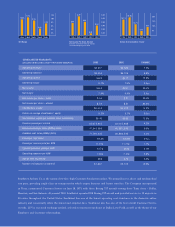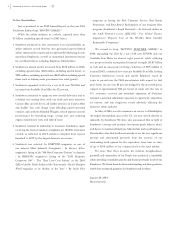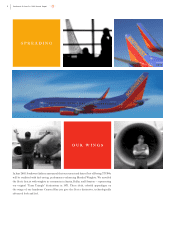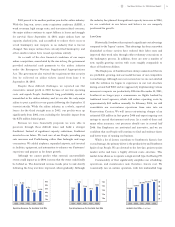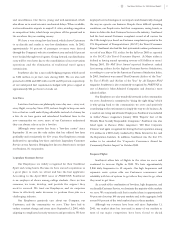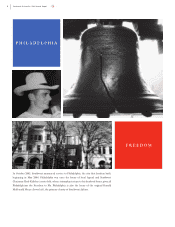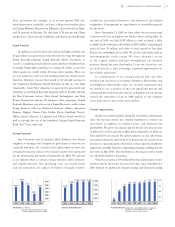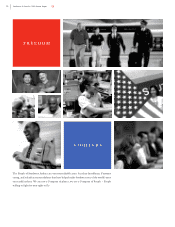Southwest Airlines 2003 Annual Report Download - page 8
Download and view the complete annual report
Please find page 8 of the 2003 Southwest Airlines annual report below. You can navigate through the pages in the report by either clicking on the pages listed below, or by using the keyword search tool below to find specific information within the annual report.
7
Southwest Airlines Co. 2003 Annual Report
and cancellations. Our fleet is young and well-maintained, which
also allows us to avoid excessive mechanical delays. Where available,
we favor alternative airports in major U.S. cities, avoiding congestion
in competitors’ hubs, which keeps our planes off the ground and in
the air where they are making money.
We have a very strong low-fare brand, which draws Customers
to us directly and results in very low distribution costs. In 2003,
approximately 54 percent of passenger revenues were derived
through the Company’s web site at southwest.com and only 16 percent
were booked through travel agents. Going forward, our distribution
costs will be even lower due to the consolidation of our reservations
operations and the elimination of traditional travel agency
commissions.
Southwest also has a successful hedging program, which saved
us $171 million in jet fuel costs during 2003. We are also well
protected in 2004 and 2005 with over 80 and 70 percent, respectively,
of our anticipated fuel requirements hedged with prices capped at
approximately $24 per barrel of crude oil.
Low Fares
Low fares has been our philosophy since day one — every seat,
every flight, every day. Since 1971, we have fought to keep our costs
low so that we could make flying affordable instead of a luxury for
a few. As we have grown and introduced Southwest fares to the
new communities we serve, more of our Customers understand
they can always rely on us for a low fare.
Although every carrier has been a “low-fare carrier” since
September 11, we are the only airline that has offered low fares
profitably and consistently for 32+ years. Our Employees remain
dedicated to spreading low fares and their Legendary Customer
Service across America. Bringing low fares to Americans is not just
our business, it’s our passion.
Legendary Customer Service
Our Employees are widely recognized for their Southwest
Spirit and caring hearts. Because we have earned a reputation as
a great place to work, we attract and hire the best applicants.
According to the April 2003 issue of FORTUNE, Southwest
is an employer of choice among college students. Once we hire
someone, we train, develop, and provide the support they
need to succeed. We trust our Employees, and we empower
them to effectively make decisions to perform their jobs in a
challenging industry.
Our Employees genuinely care about our Company, our
Customers, and the communities we serve. They have had to
endure constant change and stress since September 11, 2001, while
adapting to complicated security measures and procedures. We have
deployed new technologies at our airports and dramatically changed
the way we operate our business. Despite these difficult operating
conditions, our People never lost their compassion, caring hearts, or
desire to deliver the best Customer Service in the industry. Southwest
had the best annual Customer complaint record of all carriers for
the 13th straight year based on Customer complaints reported in the
U.S. Department of Transportation’s (D.O.T.) Air Travel Consumer
Report. Southwest also had the best systemwide ontime performance
record of any Major U.S. airline for the full year 2003 as reported
in the D.O.T.’s Air Travel Consumer Report. (A Major airline is
defined as having annual operating revenue of $1 billion or more.)
During 2003, The Wall Street Journal reported Southwest ranked
first among airlines for the highest Customer Service Satisfaction,
according to a survey by the American Customer Satisfaction Index.
In 2003, Southwest was named “Best Domestic Airline of the Year”
by Travel Weekly and “Airline of the Year” by Air Transport World
magazine. Southwest is also consistently recognized by FORTUNE as
one of America’s Most Admired Companies and America’s most
admired airline.
Our Employees are also wonderful stewards in the communities
we serve. Southwest is committed to “doing the right thing,” which
is why giving back to the communities we serve and positively
contributing to the environment is simply the way we do business. As
a result of our caring and altruistic Employees, Southwest was included
in Global Finance magazine’s January 2004 “Experts’ List of the
World’s Most Socially Responsible Companies.” Southwest was also
listed again in Business Ethics magazine’s “100 Best Corporate
Citizens” and again recognized for having the best reputation among
U.S. airlines in a 2003 study conducted by Harris Interactive Inc. and
the Reputation Institute. In addition, Southwest was the first U.S.
airline to be awarded the “Corporate Conscience Award for
Community Positive Impact” in October 2003.
Frequent Flights
Southwest offers lots of flights to the cities we serve and
continued to increase flights in 2003. We have approximately
2,800 daily frequencies to 59 airports. Our high frequencies and
expansive route system offer our Customers convenience and
reliability with lots of options to get where they want to go, when
they want to get there.
As a result of the combination of low fares, high frequencies, and
our friendly Customer Service, we dominate the majority of the markets
we serve. We consistently rank first in market share in approximately
90 percent of our top 100 city-pair markets and, in the aggregate, hold
around 65 percent of the total market share in those markets.
Although our revenues have been soft since September 11,
2001, our market share has increased in many of our markets as
most of our major competitors have been forced to shrink

